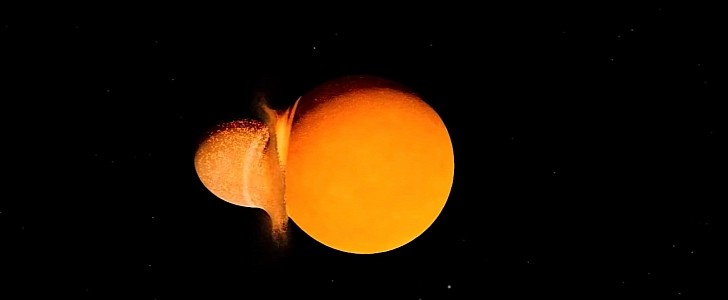Not sure how many people out there know this, but our Moon is not just some random piece of space debris, forever captured by our planet’s gravitation as it casually passed by. It is in fact a part of Earth itself, detached from it as a result of a massive impact which occurred billions of years ago.
It is then, scientists speculate, when a space rock the size of Mars, called Theia, slammed into our planet. What happened next is impossible to imagine, but we do know one result of that impact is our Moon.
There are several theories as to how this happened. The most widespread is the obvious one, which assumes the debris resulting from the impact started spinning around, coming closer and closer over the span of years, until they bonded to each other to become the Moon.
But a new computer simulation (check video below) might turn that assumption on its head, as its results point to the Moon forming in mere… hours.
A paper published in The Astrophysical Journal Letters by a team from the NASA Ames Research Center, and titled “Immediate Origin of the Moon as a Post-impact Satellite,” claims exactly that: it only took hours for the Moon to form from the bonding of material ejected after the impact.
Scientists say they've made the most detailed simulations of this kind to prove their theory, “operating at the highest resolution of any simulation run to study the Moon’s origins or other giant impacts.“
Unlike slow-formation theories, a fast-formation one would explains some mysteries about the satellite, including why the Moon’s composition is so like Earth’s. It also opens up possibilities of considering the Moon has an interior that isn't fully molten, which could explain its tilted orbit and thin crust.
So far, this remains only a theory, and will need further “analysis of future lunar samples brought back to Earth” by Artemis and other missions. In the long run, scientists say, proving or disproving it could “bring us closer to understanding how our own Earth became the life-harboring world it is today.”
There are several theories as to how this happened. The most widespread is the obvious one, which assumes the debris resulting from the impact started spinning around, coming closer and closer over the span of years, until they bonded to each other to become the Moon.
But a new computer simulation (check video below) might turn that assumption on its head, as its results point to the Moon forming in mere… hours.
A paper published in The Astrophysical Journal Letters by a team from the NASA Ames Research Center, and titled “Immediate Origin of the Moon as a Post-impact Satellite,” claims exactly that: it only took hours for the Moon to form from the bonding of material ejected after the impact.
Scientists say they've made the most detailed simulations of this kind to prove their theory, “operating at the highest resolution of any simulation run to study the Moon’s origins or other giant impacts.“
Unlike slow-formation theories, a fast-formation one would explains some mysteries about the satellite, including why the Moon’s composition is so like Earth’s. It also opens up possibilities of considering the Moon has an interior that isn't fully molten, which could explain its tilted orbit and thin crust.
So far, this remains only a theory, and will need further “analysis of future lunar samples brought back to Earth” by Artemis and other missions. In the long run, scientists say, proving or disproving it could “bring us closer to understanding how our own Earth became the life-harboring world it is today.”








